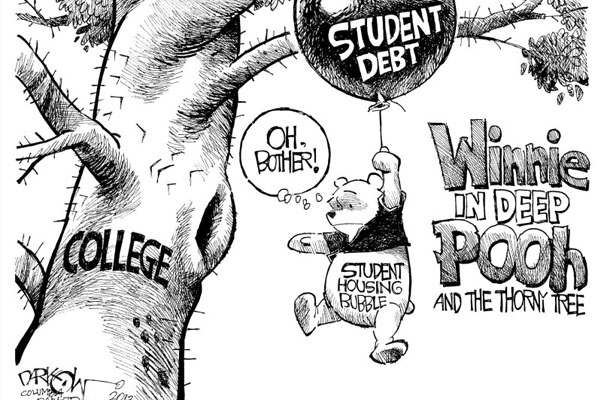Here & Abroad: A look at student loans

Afterschool Team
February 6, 2013
People find the increasing need to have a college degree to be viewed as employable.
To achieve this, some students turn to student loans to avoid the burden of the up-front payment of increased tuition fees.
There are more than 70 countries offering student loan schemes. Most of these loans are made possible by government support and are still subject to repayment. These loans vary in terms of source of initial funding, student coverage, collection method, etc. And despite varying size of repayment, loan recovery in general is considerably lower for all schemes --- it's a global phenomenon!
How the debt ballooned
In Australia, Grattan Institute released a report that shows HELP (Higher Education Loan Programme) scheme debt is now at AUD26.3 billion in outstanding loans from the Australian government to students. There are a number of reasons why student loan debt has ballooned over the years - the number of students who applied for loan went up; loans remain unpaid for several years; and repayment only happens after a student starts earning more than AUD49,095 a year.
Australians can borrow as much as AUD116,507 (for those undertaking medicine, dentistry and veterinary science) and AUD93,204 for all other students taking other courses. Students taking Maths & Science, Early Childhood and Nursing and Education receive discounts in their HELP debt repayments.
The National Higher Education Fund (PTPTN), Malaysia's government fund for students, reported debt worth RM20.3 billion in 2011. Poor loan repayments as well as poor data systems were cited as major culprits for its increase. Some industry observers believe that student loan debts hit a record high because some people decide to go back to school after being laid off.
For PTPTN, the amount of education loans provided to each student in public to study for their first degree is between RM3, 500 to RM7, 000 for science students, and from RM3, 000 to RM6, 500 a year for art students. While the amount of students at diploma level also is between RM2, 500 to RM5, 000 per year. For students in private universities, loan amount is between RM8, 500 and RM20, 000 per year for undergraduate students in the science stream, and from RM8, 000 to RM16, 000 a year for art students. For diploma students, the amount of RM3, 500 to RM5, 000 per annum.
In the United States, outstanding student loans reached nearly USD1 trillion in December 2012. According to the Federal Reserve Bank of New York, this is more than an average American owe on credit cards and even their home mortgages. Student loan debt grew by 58 per cent from USD17,233 in 2005 to USD27,253 in 2012 and delinquencies grew by 22 percent from 2007 to 2012.
The average full-time undergraduate student borrowed $4,963 in 2010.
How repayment schemes work
In most cases, borrowers take on debt levels that far exceed the reality of future starting salaries.
Sadly, only 40 per cent of college graduates with government loans could not recall receiving any consultation with regards to their student loan debt (source: NERA Economic Consulting). Furthermore, poor repayment is also caused by the inefficiencies in running the loan scheme, and high interest rate and administration costs.
According to a study by Shen and Ziderman (2008), borrowers in Czech Republic, Canada, Netherlands and Namibia repay a high price, and the most generous countries are Egypt, Nigeria and Russia wherein borrowers are required to repay about 10 per cent of the loan.
Canada's Student Loan Program (CSLP) charges a zero nominal interest rate during the period of study but charges a prime interest of 2.5 per cent. In the Czech Republic, interest rate can go above 12 per cent.
In Australia, HELP debts are managed by the Australian Taxation Office (ATO) hence borrowers will have to contact ATO to get their account information. Once a student reaches a certain repayment income (AUD49,096 for 2012-12), compulsory repayment happens and there is no charged interest. As the borrower's income increases so does his repayment rate.
This is similar with the repayment schemes of the United Kingdom, New Zealand, Sweden and South Africa where loans are repaid as a proportion of a graduate's income in each year.
In Malaysia, borrowers repay their education loan including other costs such as administrative costs, insurance costs, revenue stamp tax and other payments mentioned in the offer letter. Repayment happens after 6 months after graduation and depending on the loan amount, repayment period can take 5 (below RM10,000) to 20 years (above RM50,001).
Due to the low repayment rate, PTPTN lowered their interest from 3 per cent to 5 per cent to 1 per cent a year for borrowers and defaulters with outstanding debts. This new scheme, which kicked off in October last year, helped increase repayment rate to nearly 50 per cent.
In the US, the Department of Education uses several loan services to handle the billing and borrowers can choose and even shift among several repayment plans. Aside from the standard scheme which lasts up to 10 years at a fixed amount of at least USD50 a month, borrowers have the option to choose income-based repayment plans, pay-as-you-earn repayment plan, income-sensitive repayment plan, extended repayment plan and so forth.
Nothing comes for free....
Although loan schemes vary across the globe, they should be guided by common objectives and the most prevalent ones include: cost sharing (income generation), social objectives (improving equity and access for the poor); and easing student financial burdens by delaying fee payment.
High interest rates and other fees, however, may cast doubts on education's old-age promise of financial return. Instead of knowing how much a first degree will cost, today's students should be taught how a student loan will cost them (just when they're about to start a life) and the country's economy in the long haul. --- Lyn Cacha







